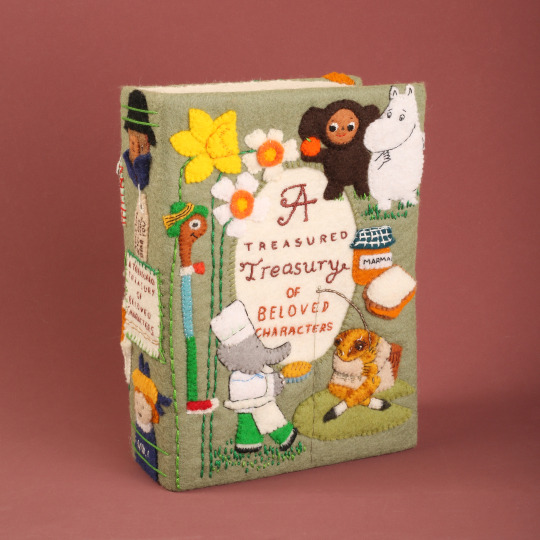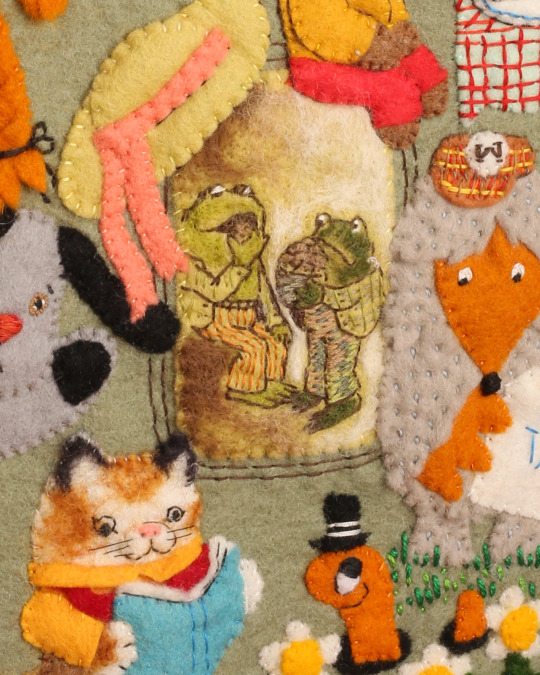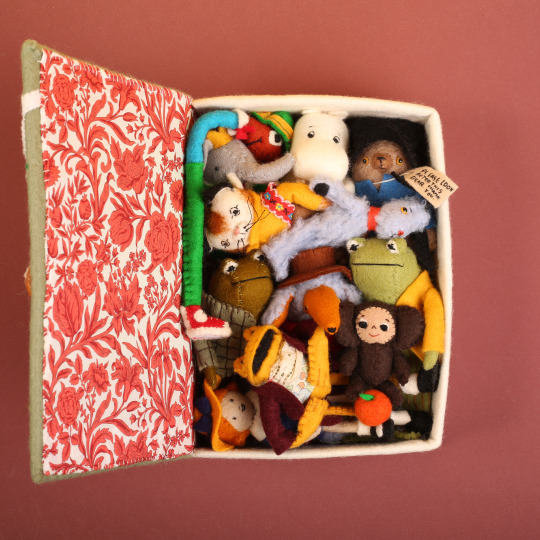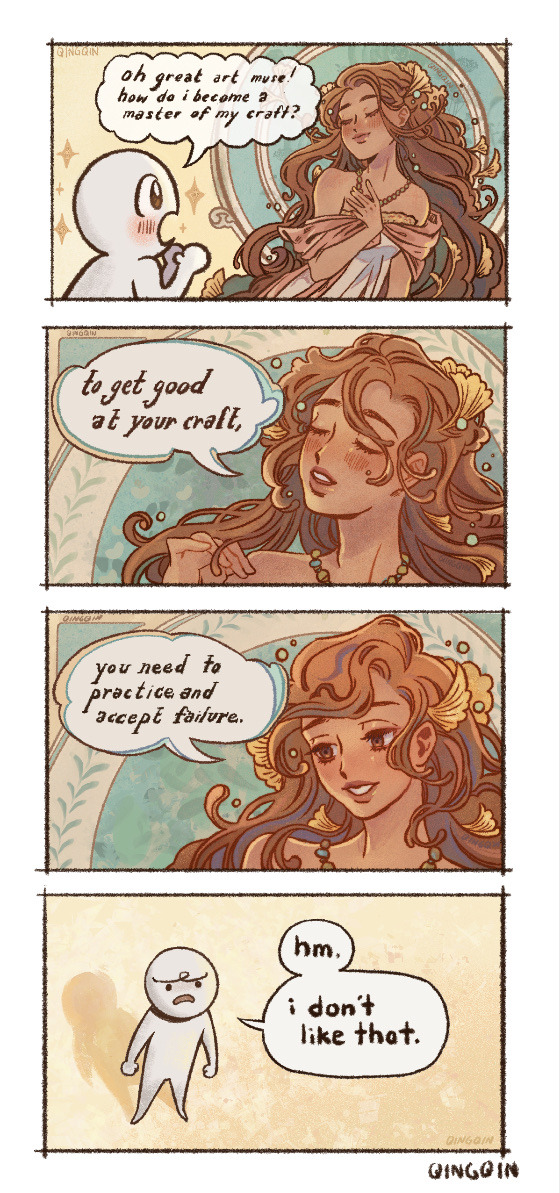501c3 educational org promoting historical and indigenous textile arts
Don't wanna be here? Send us removal request.
Text
#TextileTuesday:




“Border fragment of wool with a continuous band of #hummingbirds and fringelike appendages representing beans. Early Nasca [Nazca, Peru, c.1-450 CE]. Pollination of bean plants by birds may be suggested here. Border was formed using a needle-knit stemstitch.”
On display at American Museum of Natural History [41.2/6321]
2K notes
·
View notes
Text
Ever wanted to trade a knit hat for a necklace? Maybe the other way round? This page is a (small) attempt at trying to set those up! I'm trying to help crafty people find each other so everyone gets cool art - art trades make the world a more fun place, and it's always a great excuse to spend more time on a new piece. Would appreciate reblogs for reach!
4K notes
·
View notes
Text

Dyed some cotton napkins (from my Buy Nothing group!) for my friend’s school fundraising raffle. Madder, logwood, osage orange, and indigo, with some different kinds of resists and overdyes.
1 note
·
View note
Text




he looks funny right? you think he looks funny.
7K notes
·
View notes
Text
My favorite pants ripped so now I get to add a patch that gives the aesthetic of when a cartoon character looses their pants and are just left in the heart shaped boxers

8K notes
·
View notes
Link
Norse sails loomed off the shores of the Holy Island of Lindisfarne, along the northeastern coast of Great Britain, on June 8, 793. The seafaring invaders sacked the island’s undefended monastery.
The Viking Age had begun.
For more than 270 years, the sight of red-and-white-striped Viking sails heralded an incoming raid. Those mighty sails that drove the explorers’ ships were made by craftspeople, mostly women, toiling with spindles and looms.
“There would have been no Viking Age without textiles,” says archaeologist Eva Andersson Strand, director of the Centre for Textile Research at the University of Copenhagen, in old Viking territory.
Yet textiles have not received much attention from archaeologists until recently. Andersson Strand is part of a new wave of researchers — mostly women themselves — who think that the fabrics in which people wrapped their bodies, their babies and their dead were just as important as the clay pots in which people preserved food, or the arrowheads with which hunters took down prey.
These researchers want to know how ancient spinners and weavers, from Viking territory and elsewhere in Europe and the Middle East, fashioned sheep’s coats into sails — as well as diapers, shrouds, tapestries and innumerable other textiles. Since the Industrial Revolution, when fabric crafts migrated from hearth to factory, most people have forgotten how much work it once required to create a tablecloth or wedding veil, or 120 square meters of sailcloth to propel a longboat across the water.
Textile making is “one of the major industries, and always has been,” says Lise Bender Jørgensen, an archaeologist at the Norwegian University of Science and Technology in Trondheim. Today, the annual global market for yarns and fabrics is worth nearly $1 trillion.
Before the 1764 invention of the mechanical spinning jenny, people twisted fibers — flax or wool, for example — together by hand to spin a strong thread. The person doing the spinning would pinch a few strands from a mass of fibers and hook it to a hand-length stick called a spindle. A small, round weight, called a whorl, helped the spindle turn. By dangling the turning spindle, the spinner could twist the fibers into long threads.

Katrin Kania, a textile archaeologist based in Germany, shows how a spinner makes thread. Here, she pinched a bit from a mass of fibers, attaching it to the spindle in her right hand. A whorl at the spindle’s bottom helps the tool spin and create thread. CREDIT: KARL-FRIEDRICH PFEIFFER
Weavers then attached these threads to a loom, crisscrossing the fibers. That mesh could be loose and open, or tight and dense, depending on the fabric desired.
People have been using fibers for millennia, for string and rope as well as thread, and probably started spinning around the fourth millennium B.C., says Margarita Gleba, an archaeologist at the University of Cambridge. Loom-based weaving, which evolved from basketry, happened as early as the seventh millennium B.C. in Turkey. Back then, the threads were made by splicing.
The ancient textile industry has been difficult to study. Unlike pottery or arrowheads, organic textiles rapidly degrade. Archaeologists interested in what people wove and wore in the past make do with scraps of material preserved by luck — for example, if the fabric happened to be buried in bogs or salt mines.
While some researchers have analyzed the bits of fabric they can find, Andersson Strand is more interested in the production process and its context — the cultural and economic impact. She wants to know what life was like for the people who made textiles thousands of years ago. How much of women’s time was taken up with spinning and weaving? Did textile workers specialize in one part of the process? And did techniques vary by culture?
To understand the work of European spinners and weavers from centuries past, she has turned to the remains of tools that once created those fabrics. Made of clay, stone or bone, the whorls that twirled the spindles and the loom weights that kept the threads taut during weaving are abundant at many archaeological sites.
Andersson Strand uses experimental archaeology to learn what kind of threads and fabrics — fine or coarse, dense or airy — would result from different tools. Her findings are helping archaeologists infer from the leftover tools what textiles people might have created and traded.
“She’s really made the textile tools speak,” Bender Jørgensen says. But not all scholars agree that the tools determine the fabric. Some researchers suggest that the individual crafter, inaccessible to archaeologists, was a more important factor in how spun threads turned out.
323 notes
·
View notes
Text




A Treasured Treasury of Beloved Characters (2024).
Wool felt, cotton lawn, strawboard, embroidery & poly cotton thread, recycled PET stuffing, armature wire, plastic eyes.
Here is a collection of characters I met when I was small, all of whom have stayed with me every day since. They are housed, stitched and squished in this felt book, akin to their arrangement in my brain.
Posters available here.
9K notes
·
View notes
Text
Bought a new spinning wheel in a charity shop today
221 notes
·
View notes
Text
Tried to post this earlier but it didn't take for some reason so if it randomly pays a bunch of times, whoops
Teacher from my spindle class at the Hanspinning Seminar showing us how to spin with a distaff, featuring my shitty videography
127 notes
·
View notes
Text
Someday your hands will be old and wrinkled, the skin spotted and bunching over your knuckles. And a child will watch you make something. It's a simple task, you'll have done it a thousand times before. But to that child, the smooth, confident way your hands move will seem like impossible magic. You have to keep living.
59K notes
·
View notes
Text
Tablet weaving pattern from Byzantine Egypt
This is the original band, found in Necropolis D in Antinoöpolis, Egypt. It has been dated to c. 395-641 CE. It is currently held in the Louvre.

This is the threading diagram and turning sequence. The shaded squares indicate the cards should be turned backwards. The pattern is fortunately twist-neutral!

Here's how my reconstruction turned out:

The original weft used was a very fine natural linen thread but I chose to use the same white yarn as in the warp.
514 notes
·
View notes
Text
Spin Together is a social, friendly competition of a week of spinning from Feb 22-March 1. Griffin Dyeworks hosts a team, and we welcome spinners of all skill levels and tool preference! We have daily virtual check ins and hopefully some in-person as well (Los Angeles and wherever we have multiple team members). It’s a great opportunity to meet spinners, ask and give advice, and dedicate a little time to spinning each day.
It’s $15 to join, and Griffin Dyeworks can cover that for you if needed, just message me. Learn more and sign up until Feb 15 at http://spintogether.org with Griffin Dyeworks Spinners!
(Ignore the preview text, the website is up to date)

#spinning#hand spinning#wheel spinnning#electric spinning wheel#spindling#spindles#textiles#spinning wool#drop spinning#spin together#griffin dyeworks spinners
10 notes
·
View notes
Text

I love this free cross stitch pattern by Abby M. According to her, donations are welcome but not expected or required!
I saw the pattern itself on a cross stitch facebook group I'm in and I'm a little disappointed I have too many big projects lined up to stitch it, but it's so delightful!
477 notes
·
View notes


